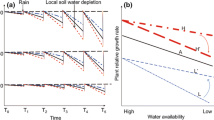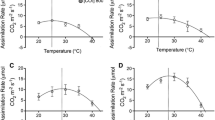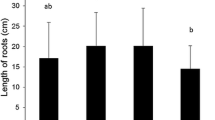Abstract
In order study C3 and C4 plant growth in atmospheric CO2 levels ranging from past through predicted future levels, Abutilon theophrasti (C3) and Amaranthus retroflexus (C4) were grown from seed in growth chambers controlled at CO2 partial pressures of 15 Pa (below Pleistocene minimum), 27 Pa (pre-industrial), 35 Pa (current) and 70 Pa (predicted future). After 35 days of growth, CO2 had no effect on the relative growth rate, total biomass or partitioning of biomass in the C4 species. However, the C3 species had greater biomass accumulation with increasing CO2 partial pressure. C3 plants grown in 15 Pa CO2 for 35 days had only 8% of the total biomass of plants grown in 35 Pa CO2, C3 plants had lower relative growth rates and lower specific leaf mass than plants grown in higher CO2 partial pressures, and aborted reproduction. C3 plants grown in 70 Pa CO2 had greater root mass and root-to-shoot ratios than plants grown in lower CO2 partial pressures. These findings, support other studies that show C3 plant growth is more responsive to CO2 partial pressure than C4 plant growth. Differences in growth responses to CO2 levels of the Pleistocene through the future suggest that competitive interactions of C3 and C4 annuals have changed through geologic time. This study also provided evidence that C3 annuals may be operating near a minimum CO2 partial pressure for growth and reproduction at 15 Pa CO2.
Similar content being viewed by others
References
Acock B, Reddy VR, Del Castillo D, Hodges HF, Baker DN, Mckinion JM, Whisler FD (1983) Soybean responses to carbon dioxide: measurement and simulation 1982. In: Responses of vegetation to carbon dioxide series, no 008. US Department of Energy and U.S. Department of Agriculture Joint Program Report of Research, Office of Energy Research, U.S. Department of Energy, Washington, D.C.
Allen LH Jr, Vu CV, Valle RR, Boote KJ, Jones P (1988) Nonstructural carbohydrates and nitrogen of soybean grown under CO2 enrichment. Crop Sci 28:84–94
Allen LH Jr, Bisbal EC, Boote KJ, Jones PH (1991) Soybean dry matter allocation under subambient and superambient levels of carbon dioxide. Agron J 83:875–883
Barnola JM, Raynaud D, Korotkevich YS, Lorius C (1987) Vostoc ice core provides 160,000-year record of atmospheric CO2. Nature 329:408–414
Bazzaz FA (1990) The response of natural ecosystems to the rising global CO2 levels. Annu Rev Ecol Syst 21:167–196
Bazzaz FA, Garbutt K, Williams WE (1985) Effect of increased atmospheric carbon dioxide concentration on plant communities. in: Strain BR, Cure JD (eds) Direct effects of increasing carbon dioxide on vegetation. Department of Energy, Carbon Dioxide Research Division, Washington D.C.
Bazzaz FA, Garbutt K, Reekie EG, Williams WE (1989) Using growth analysis to interpret competition between a C3 and C4 annual under ambient and elevated CO2. Oecologia 79:223–235
Bowler JM, Press MC (1993) Growth responses of two contrasting upland grass species to elevated CO2 and nitrogen concentration. New Phytol 124:515–522
Carter DR, Peterson KM (1983) Effects of a CO2-enriched atmosphere on the growth and competitive interaction of a C3 and C4 grass. Oecologia 58:188–193
Coleman JS, Bazzaz FA (1992) Effects of CO2 and temperature on growth and resource use of co-occurring C3 and C4 annuals. Ecology 73:1244–1259
Downs RJ, Hellmers H (1978) Controlled climate and plant research. (World Meteorological Organization, Tech Note no 148). Academic Press, Geneva
Ehleringer JR, Sage RF, Flanagan LB, Pearcy RW (1991) Climate change and the evolution of C4 photosynthesis. Trends Ecol Evol 6:95–99
Farquhar GD, Sharkey TD (1982) Stomatal conductance and photosynthesis. Annu Rev Plant Physiol 33:317–345
Garbutt K, Williams WE, Bazzaz FA (1990) Analysis of the differential response of five annuals to elevated CO2 during growth. Ecology 71:1185–1194
Hellmers H, Giles LJ (1979) Carbon dioxide: critique I. In: Tibbitts TW, Kozlowski TT (eds) Controlled environment guidelines for plant research. Academic Press, New York, pp 229–234
Hunt R, Parsons IT (1974) A computer program for deriving growth-functions in plant growth-analysis. J Appl Ecol 11:297–307
Keeling CD, Bacastow RB, Carter AF, Piper SC, Whorf TP, Heimann M, Mook WG, Roeloffzen H (1989) A 3-dimensional model of atmospheric CO2 transport based on observed winds. I. Analysis of observational data. In: Peterson DH (ed) Aspects of climatic variability in the Pacific and the Western Americas. Geophys Monogr 55:165–235
Květ J, Ondok JP, Nečas J, Jarvis PG (1971) Methods of growth analysis. In: Šesták Z, Catský J, Jarvis PG (eds) Plant photosynthetic production. Manual of methods. Junk, The Hague, pp 343–391
Lovelock JE, Whitfield M (1982) Life span of the biosphere. Nature 296:561–563
Norby RJ, O'Neill EG (1991) Leaf area compensation and nutrient interactions in CO2-enriched seedlings of yellow-poplar (Liriodendron tulipifera L.). New Phytol 117:515–528
Norby RJ, Luxmoore RJ, O'Neill EG, Weller DG (1984) Plant responses to evevated atmospheric CO2 with emphasis on belowground processes. Oak Ridge National Laboratory, Tenn
Overdieck D, Reid C, Strain BR (1988) The effects of preindustrial and future CO2 concentrations on growth, dry matter production and the C/N relationship in plants at low nutrient supply: Vigna unguiculata (cowpea), Abemoschus esculentus (okra) and Raphanus sativus (radish). Botanik 62:119–134
Patterson DT, Flint EP (1980) Potential effects of global atmospheric CO2 enrichment on the growth and competitiveness of C3 and C4 weed and crop plants. Weed Sci 28:71–75
Patterson DT, Flint EP, Beyers JL (1984) Effects of CO2 enrichment on competition between a C4 weed and a C3 crop. Weed Sci 32:101–105
Pearcy RW, Björkman O, Caldwell MM, Keely JE, Monson RK, Strain BR (1987) Carbon gain by plants in natural environments. BioScience 37:21–29
Polley WH, Johnson HB, Mayeux HS (1992) Carbon dioxide and water fluxes of C3 annuals and C3 and C4 perennials at subambient CO2 concentrations. Funct Ecol 6:693–703
Polley WH, Johnson HB, Marino BD, Mayeux HS (1993) Increase in C3 plant water-use efficiency and biomass over glacial to present CO2 concentrations. Nature 361:61–64
Quade J, Cerling TE, Bowman JR (1989) Development of Asian monsoon revealed by marked ecological shift during the latest Miocene in northern Pakistan. Nature 342:163–165
Sionit N, Patterson DT (1984) Responses of C4 grasses to atmospheric CO2 enrichment. I. Effect of irradiance. Oecologia 65:30–34
Thomas BA, Spicer BR (1987) The evolution and palaeobiology of land plants. Croom Helm, London
Thomas JF, Harvey CN (1983) Leaf anatomy of four species grown under continuous CO2 enrichment. Bot Gaz 144:303–309
Thomas RB, Strain BR (1991) Root restriction as a factor in photosynthetic acclimation of cotton seedlings grown in elevated carbon dioxide. Plant Physiol 96:627–634
Tissue DT, Thomas RB, Strain BR (1993) Long term effects of elevated CO2 and nutrients on photosynthesis and rubisco in loblolly pine seedlings. Plant Cell Environ 16:859–865
Tissue DT, Griffin KL, Thomas RB, Strain BR (1995) Effects of low and elevated CO2 on C3 and C4 annuals. II. Photosynthesis and leaf biochemistry. Oecologia 101:21–28
Vu CV, Allen LH Jr, Bowes G (1989) Leaf ultrastructure carbohydrates, and protein of soybean grown under CO2 enrichment. Environ Exp Bot 29:141–147
Wray SM, Strain BR (1987) Competition in old-field perennials under CO2 enrichment. Ecology 68:1116–1120
Zangerl AR, Bazzaz FA (1984) The response of plants to elevated CO2. II. Competitive interactions among annual plants under varying light and nutrients. Oecologia 62:412–417
Author information
Authors and Affiliations
Rights and permissions
About this article
Cite this article
Dippery, J.K., Tissue, D.T., Thomas, R.B. et al. Effects of low and elevated CO2 on C3 and C4 annuals. Oecologia 101, 13–20 (1995). https://doi.org/10.1007/BF00328894
Received:
Accepted:
Issue Date:
DOI: https://doi.org/10.1007/BF00328894




